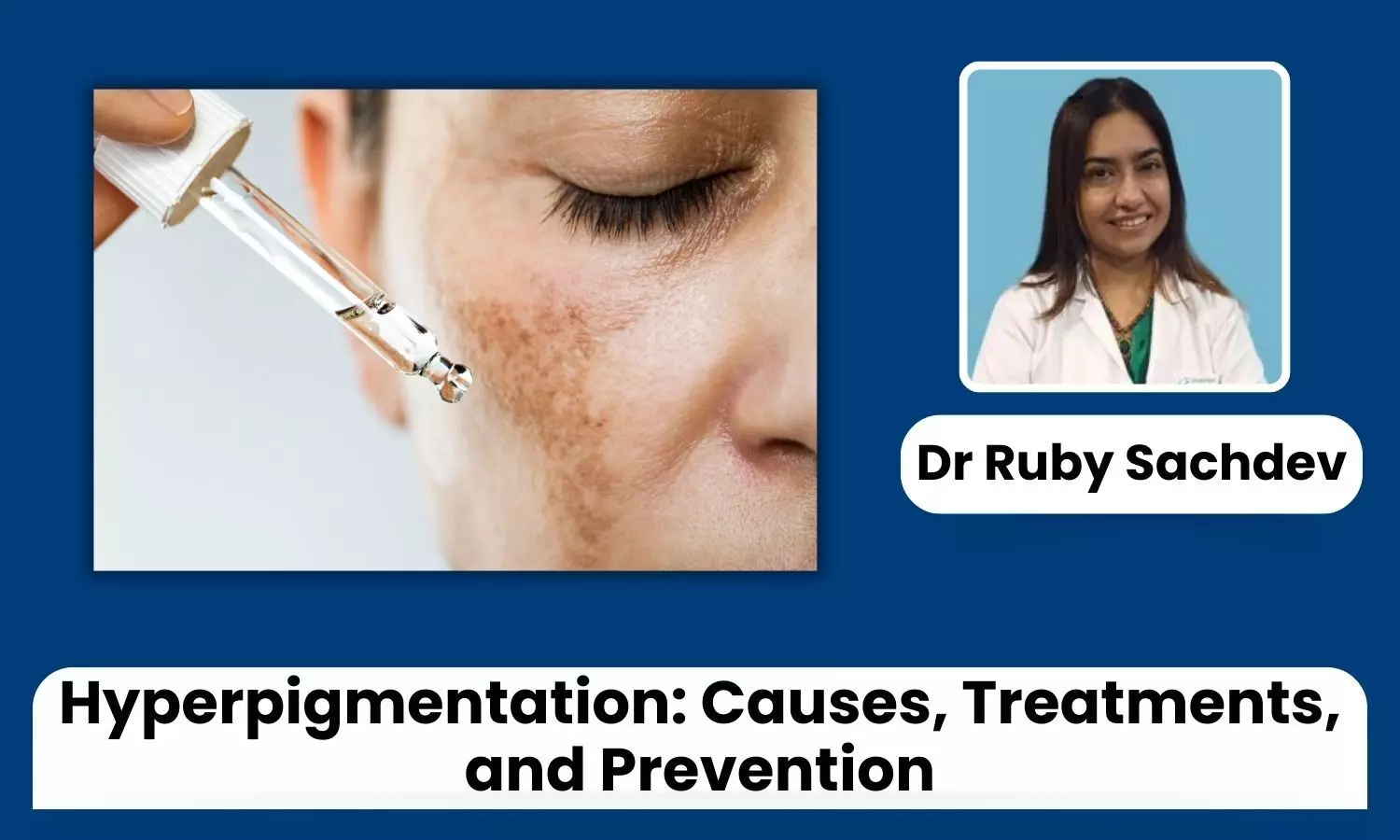From Sunspots to Melasma: Your Guide to Fading Hyperpigmentation - Dr Ruby Ahuja Sachdev

Hyperpigmentation is a common skin condition characterized by the darkening of certain areas of the skin due to an overproduction of melanin. While typically harmless, hyperpigmentation can be a significant cosmetic concern for many individuals, affecting their self-esteem and overall appearance. This article explores the causes, treatments, and preventive measures for hyperpigmentation, providing insights from the perspective of aesthetic consultants.
Causes of Hyperpigmentation
Hyperpigmentation can result from various factors, each triggering an increase in melanin production. The most common causes include:
1. Sun Exposure: Ultraviolet (UV) rays from the sun are a major cause of hyperpigmentation. Prolonged exposure can lead to the formation of sunspots, also known as age spots or liver spots, which are small, dark patches on the skin.
2. Hormonal Changes: Hormonal fluctuations, particularly during pregnancy or due to oral contraceptives, can lead to a type of hyperpigmentation called melasma. This condition is often characterized by brown or gray-brown patches on the face, particularly on the cheeks, forehead, and upper lip.
3. Post-Inflammatory Hyperpigmentation (PIH): This type of hyperpigmentation occurs following an injury or inflammation to the skin, such as acne, eczema, or psoriasis. The skin produces excess melanin as it heals, leading to dark spots or patches.
4. Aging: As we age, our skin's ability to regenerate and heal slows down. This natural process can result in the appearance of dark spots, especially in areas exposed to the sun.
5. Certain Medications: Some medications, such as chemotherapy drugs, antibiotics, and antimalarials, can cause hyperpigmentation as a side effect.
6. Skin Injuries: Cuts, burns, and even certain cosmetic procedures like laser treatments can sometimes lead to hyperpigmentation during the healing process.
Treatment Options for Hyperpigmentation
Treating hyperpigmentation requires a targeted approach, tailored to the underlying cause and the individual’s skin type. Aesthetic consultants often recommend the following treatments:
1. Topical Treatments:
- Glycolic Acid & Kojic Acid: A popular alpha hydroxy acid (AHA), glycolic acid exfoliates the skin, reduces dark spots, and enhances skin texture by revealing a brighter complexion.
- Retinoids: Retinoids, such as tretinoin, are vitamin A derivatives that promote skin cell turnover and help fade hyperpigmentation over time.
- Vitamin C: A potent antioxidant, vitamin C helps brighten the skin and reduce the appearance of dark spots by inhibiting melanin synthesis.
- Niacinamide: This form of vitamin B3 helps to reduce the transfer of melanin to skin cells, thereby lightening dark spots and improving skin tone.
2. Chemical Peels: Chemical peels involve applying a solution to the skin that exfoliates the outer layers, promoting the growth of new, evenly pigmented skin. Peels containing glycolic acid, salicylic acid, or lactic acid are commonly used to treat hyperpigmentation.
3. Laser Therapy: Laser therapy is an effective option for targeting and breaking down melanin deposits, helping to treat hyperpigmentation. Popular choices include Q-switched lasers and fractional lasers, which are designed to minimize pigmentation without damaging surrounding tissue. Intense Pulsed Light (IPL) is also widely used for skin tone correction. However, caution is essential, especially for individuals with darker skin tones, as improper use can lead to complications like further pigmentation or scarring.
4. Microdermabrasion: This procedure involves physically exfoliating the top layer of the skin using a special device, promoting the growth of new skin cells and reducing the appearance of dark spots.
5. Microneedling: Microneedling creates tiny punctures in the skin, stimulating collagen production and helping to improve skin texture and tone, including areas affected by hyperpigmentation.
Prevention of Hyperpigmentation
Preventing hyperpigmentation is often easier than treating it. Aesthetic consultants emphasize the importance of the following preventive measures:
1. Sun Protection: Daily use of broad-spectrum sunscreen with at least SPF 30 is crucial in preventing hyperpigmentation. Sunscreen should be reapplied every two hours when outdoors, especially after swimming or sweating. Wearing protective clothing, hats, and sunglasses also helps shield the skin from UV rays.
2. Avoiding Direct Sunlight: Limiting exposure to direct sunlight, particularly during peak hours (10 a.m. to 4 p.m.), can significantly reduce the risk of developing hyperpigmentation.
3. Gentle Skin Care: Using gentle skincare products and avoiding harsh exfoliants or aggressive treatments can prevent irritation and inflammation, which could lead to post-inflammatory hyperpigmentation.
4. Regular Skin Check-ups: Regular consultations with an aesthetic consultant or dermatologist can help monitor skin changes and provide early intervention for any developing hyperpigmentation issues.
5. Healthy Lifestyle Choices: Maintaining a balanced diet rich in antioxidants, staying hydrated, and managing stress can all contribute to healthy skin and reduce the likelihood of hyperpigmentation.
Conclusion
Hyperpigmentation, though common, can be effectively managed with the right approach. Understanding the causes and exploring appropriate treatment options, coupled with diligent preventive measures, can help individuals achieve and maintain a more even and radiant complexion. Consulting with an aesthetic specialist is key to developing a personalized plan that addresses specific skin concerns and enhances overall skin health.


